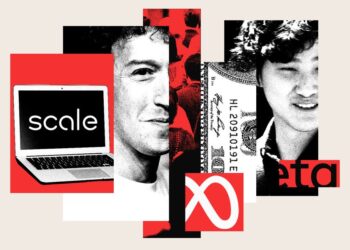SAN FRANCISCO — It takes Tazo Stuart-Riascos 28,000 steps per day to make ends meet in one of America’s most unaffordable places.
He begins clocking that prodigious number of paces before sunrise, as he hustles from his apartment in Oakland to his retail job in San Francisco, then back to the East Bay for his night shift at Trader Joe’s, where he’s on his feet until 10 p.m. All that scrambling and Stuart-Riascos still just barely gets by.
He’s part of a growing number of people — many working one or more jobs — who find themselves struggling to stay afloat as the cost of living skyrockets and wages fail to keep pace, making it even harder to survive in the already-expensive Bay Area.
“It’s the new standard of living in California,” Stuart-Riascos, 36, said. “People aren’t surprised you’re working two jobs nowadays. It’s this normal thing. You try to work your way out, but you’re actually working your way further in.”
For the first time in more than a decade, the Bay Area’s poverty rate is rising significantly, jumping by more than 4 percent in less than a year, according to an analysis released Wednesday by Tipping Point Community, a San Francisco-based anti-poverty nonprofit organization founded 20 years ago by the man who is now the city’s mayor.
More than a million Bay Area residents live in poverty — an income of less than $28,000 per year for one adult — and about 800,000 others are near the line, according to the study. It relies on data through 2023, the most recent numbers available. The spike of poverty across the region, which includes six counties that ring San Francisco Bay, outpaced the statewide increase and widened existing racial and educational disparities.
Stuart-Riascos, like other residents fighting to afford their basic needs, said he feels “stuck in survival mode” and is questioning his future in the place where he was born and raised. Two-thirds of his monthly income goes to rent — well beyond what researchers consider to be “severely cost burdened.”
“I don’t think it’s sustainable at all,” he said.
Even as San Francisco appears to undergo a resurgence — with crime rates falling, optimism rising and money from the booming artificial intelligence industry pouring in — the analysis suggests the reality is far more complicated. By one count, the Bay Area is home to more billionaires than any other metro area, but rising prices are driving more people into poverty, making the region one of the most visibly unequal in the country.
“We want there to be prosperity in the Bay Area, but what this report shows is that we’re at risk of leaving a bunch of people behind,” said Sam Cobbs, the CEO of Tipping Point Community. “You’re talking about people who want to chase what we call the American Dream, but it’s a lot harder for them to do that in the Bay Area if they’re just getting started.”
From 2021 to 2023, average income here increased by about 10 percent, but the cost of living soared by nearly twice that, the study found. At the same time, the many safety-net programs rolled out during the pandemic — including the federal child tax credit, stimulus payments and expanded unemployment and food assistance — have expired.
“The safety net went back to the way it was, but the rest of the world didn’t,” said Ryan Finnigan, the deputy director of research at UC Berkeley’s Terner Center for Housing Innovation. “It’s easy to see how people lost ground.”
The AI frenzy continues to inflate rental prices, making the housing market in San Francisco one of the most competitive in the nation. The city’s transit agency faces a budget crisis that could jeopardize the reliability of the buses and trains so many depend on for their commutes. And coming cuts to Medicaid and food stamps, the result of President Donald Trump’s spending bill, will increase the pressure on families who are already on the brink.
“There’s concern these numbers will only get worse,” said Ali Sutton, Tipping Point Community’s chief program officer.
Residents are already feeling that squeeze in ways big and small. Judy Chow, a San Francisco native and retired educator, began picking up substitute teaching shifts to pay her property taxes and utility bills. Her three adult children love the city, but they can’t afford to live here.
“The water, the electricity, the garbage, all that goes up,” said Chow, 70.
The young teachers she works with either live with their parents or squeeze into rentals. Many burn out quickly. Others move away.
“Young people are leaving San Francisco,” Chow said. “We’re losing them, and we’re not getting new blood.”
A job, like teaching, that once felt secure now does not seem like enough. Bryce Duncan, a civil engineer who inspects construction sites, said he used to drink about two gallons of milk per week. He has cut back to one per month. When his wife, who juggles three jobs, asks him about starting a family, he tells her they should put it off until they’re on more stable financial footing.
“I don’t know if we could really raise a family feasibly here,” said Duncan, 27.
Others have come to the same conclusion: San Francisco has the smallest share of children among all major U.S. cities.
Even tech workers are getting crunched. Layoffs at some of the region’s largest companies have left thousands newly unemployed, as firms restructure and embrace AI. The market for new openings is fierce, said J. Marie Valdivia, who was laid off two years ago and has been hunting for a full-time job since. She took shifts at a coffee shop and began volunteering at a food pantry in the Inner Richmond neighborhood — a gig that both buoyed her spirit and gave her access to a steady supply of food assistance.
“I never thought I would be in this situation,” said Valdivia, 44.
The city feels like it has become more unequal, she said. Many of her friends in tech are also laid off — they meet every Monday to job hunt together and share tips about who is hiring — but those still employed seem to be doing better than ever.
“Half the neighborhood is laid off and in poverty,” Valdivia said. “The other half is extremely wealthy and extremely privileged.”
That contrast is visible everywhere. The city’s skyline is pushing further into the clouds, while on the streets below, unhoused residents remain mired in mental health crises. On a recent afternoon, one unemployed resident standing in line outside the food pantry where Valdivia was working watched as a driverless Waymo taxi rolled by.
“Talk about a tale of two cities,” said the man, who declined to share his name. “Here we are waiting in line to get food, and you have robot cars.”
Researchers say the trends outlined in the Tipping Point Community report should compel governments and philanthropies to shore up the social safety net before the crisis worsens. San Francisco Mayor Daniel Lurie, who took office in January, said his administration has sought to address some of the issues outlined in the analysis.
When the White House refused to cover Americans’ food assistance during the government shutdown, Lurie announced the city would send its residents preloaded cards to fill the gap. And he is pushing zoning changes that would allow thousands of new homes to be built.
“I’ve seen government fail to support families in our city who are struggling to pay rent and put food on the table,” Lurie, who left Tipping Point before he began his political career, said in a statement. “We will continue our work to create economic opportunity and support families in San Francisco — giving those on the street a bed to sleep in, opening businesses and creating jobs, and protecting affordable, reliable public transit.”
Still, for residents like Stuart-Riascos, the daily grind remains a battle. As a graduate of the foster care system and a survivor of homelessness, he knows how to scratch out a living in the Bay Area. But the sacrifices take a toll. He’s often too busy with work to exercise, prepare healthy meals, tend to his mental health or pursue romantic relationships.
“There’s not enough time in the day to do it all,” Stuart-Riascos said. “Especially if you plan on sleeping.”
The post Poverty spikes in the land of the tech billionaires
appeared first on Washington Post.




